Ijraset Journal For Research in Applied Science and Engineering Technology
- Home / Ijraset
- On This Page
- Abstract
- Introduction
- Conclusion
- References
- Copyright
People Thinking General Facts About Electric Vehicles In India 2022
Authors: James Prasadh V
DOI Link: https://doi.org/10.22214/ijraset.2022.43280
Certificate: View Certificate
Abstract
This study about how people thinking general facts about electric vehicles in 2022.This study explore how the people still thinking about electric vehicles in India. Is there any changes need to promoting electric vehicles brand name than promoting electric vehicle as a brand? This study helps to find that electric vehicle is safe or not & currently still what they are need to develop in electric vehicle, based on study what are all the possibilities are there to improve manufacturing safest electric vehicles to get better outcome. One of the major considerations is electric vehicle mileage range to increase the performance of the vehicle to make worth of buying electric vehicles. Descriptive analysis used to clearly state that what are all the things still need to be developed in electric vehicle how can be making the product more useful with environment friendly.
Introduction
I. INTRODUCTION
There is no need for introduction about electric vehicle. Now a days everyone knows electric vehicle is one of the alternative fuel vehicles. Some people choosing electric vehicle is a vehicle for them. But many people prefer only other fuel vehicles for some reasons. Electric vehicle is more silent when driving compare to another vehicle.
Easy to maintained and operating costs are very less. The effective technology used to design a vehicle cheaper. In electric vehicle battery designing is a more challengeable one for every manufactures. Because of the higher mileage range aspects making a battery is not so easy, what we expect than reality. It depends upon the electric vehicle battery weight, vehicle design, and required battery space etc.
Many electric vehicles are coming with advanced technology used to increase the performance of the vehicle. Better performance means making more reliable electric vehicle than other fuel vehicle performance. It can help to clearly standout the capturing electric vehicle market even competitor arising in the field. But in reality, some features are not useful for electric vehicle users. The best example is automatic lane changing features are not useful for Indian roads. Affordability of the electric vehicle is biggest challenge & cost cutting factor to reduce the technology used in electric vehicle. Another major consideration is charging stations, In India still need to develop more charging stations.
II. THEORETICAL FRAMEWORK
Electric Vehicles (EVs) are run by electric motors which are powered by energy stored in batteries. Electric vehicles have an electric motor instead of an Internal Combustion Engine (ICE). As an electric vehicle runs only on electricity, there is no chance to emits any smoke because electric motors no need for exhaust from a tailpipe i.e., it has zero tail pipe emission and does not contain some components, such as a fuel pump, fuel line or fuel tank.
A. Types of Electric Vehicles
Electric vehicles are classified into three types.
- Plug in Hybrid Electric Vehicles (PHEVs)
- Hybrid Electric Vehicles (HEVs)
- Battery Electric Vehicles (BEVs)
PHEVs use both petrol / diesel and electricity. These vehicles have two power systems, an internal combustion engine and a battery. The battery can be recharged by plugging the vehicle into an external source. HEVs combine conventional ICE systems with electric propulsion systems.
Regenerative braking technology used to convert one energy into another energy, from that is normally wasted during braking mechanical energy converted into electricity. This producing electricity is kept & stored in a battery.
III. ELECTRIC VEHICLE FACTS
A. Transport Sector Emissions
Transport sector is the major consideration of emissions because petrol and diesel vehicle polluted the environment. In Delhi every year so many people affected breathing the polluted air. Government takes various steps to reduce the usage of petrol / diesel vehicle in Delhi. This is the example of petrol / diesel vehicles are polluting air.
B. Nature of Charging
Time of electric vehicle charging is depending on slow/moderate/fast chargers. Slow and moderate chargers took up to 1 to 8 hours for full charge. But Fast chargers charging from 0 % to 80% took up to 1 to 2 hours.
C. Cost
Electric vehicle initial cost of purchasing price is high but the charging, maintenance and operational cost is lower than internal combustion engine. But the government giving subsidy for those who all are buy electric vehicles in India.
D. Low Range
Now the modern batteries are average range for 2 wheelers around 80km to 100 km and for 4 wheelers around 120km to 250km.It is sufficient for daily commute. When short distance travel it is enough to manage everyday life. Further better battery research and development phase make the battery more mileage range than current mileage range of electric vehicles.
E. Battery Safety
Most of the Electric vehicle manufacturers with their efficient and intelligent Battery Management Systems (BMS) protecting the nature of the battery by cooling, heating, insulation ,thermal protection & ventilation etc. Many certification agencies, Automotive Research Association of India (ARAI), International Centre for Automotive Technology (ICAT) testing the battery in various conditions. It ensures that electric vehicle is safe to drive on road. Somehow battery explosion is happen most of the time. Still every electric vehicle manufactures research and development group need to develop the battery for safety aspects.
F. Low Speed
Electric vehicles are mostly high-speed powertrains. But in Indian market based on the product & model & purpose & usage & price to decided top speed of the vehicle. Normally electric vehicles have a high starting torque to be produced when compare with the internal combustion engine.
G. Battery Replacement
Electric vehicle batteries warranty is very less. Now a days warranty covers between 3 to 8 years, across electric 2-wheeler, 3-wheeler and 4-wheeler categories. The actual battery warranty may vary depending upon the vehicle usage. So, need to change the battery frequently.
H. Fewer Charging Stations
Government giving subsidy to private sector and increase the charging stations availability.It’s very helpful for electric vehicle buyers because it will take only less charging time when compare to other option to charge.
IV. RESEARCH METHODS & DATA COLLECTION
This study took descriptive research design that was conducted using both qualitative and quantitative approaches. This involves examining and analyzing how people thinking the general facts about electric vehicle in current condition. The researcher collected both data, primary and secondary data from respondents of the study.
The study was conducted in Chennai. I select this location due to that I’m familiar in this city, to know the general facts about electric vehicle in current condition. Thus, this made easy for a researcher to collect the required data during the study.
The researcher chosen public places in Chennai like colleges, schools, bus stand, residential areas, private parks, hospitals, hotels, malls etc. The researcher randomly selected people from the available population. A total of 100 respondents are involved in this study. Some participants are involved in the interviewing method to collect the data. The researcher analyzed various case study for this data collection.
Already existing secondary data collected from newspapers, journals, websites. Observation was made by a researcher to understand the physical environment when it favors the understanding general facts about electric vehicle in current condition. The method helped to collect the data that were not obtained through questionnaire, interview and documentary views and it was used to compare with data collected through other methods. These documents were retrieved from libraries, organizations that relate to the research. Therefore, this method involved the researcher in reviewing available records on electric vehicles.
The data was collected from google forms to analyse the data. Data from interview and documentary analysis were recorded and analyzed after the end of each session. Research ethics covers a number of concerns including ensuring the security welfare of those who participate in the study, never revealed the participants identity at any reasons. Maintaining integrity in conducting research and treating information given by participants with utmost secrecy and confidentiality.
V. DATA ANALYSIS & INTERPRETATION
This topic presents data from the questionnaires, interviews, documents analysis and observation, data regarding how people thinking general facts about electric vehicles in 2022.
A. Data Presentation
- Gender of Respondents
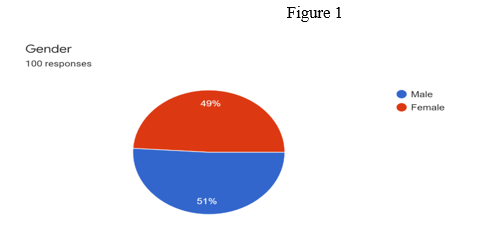
From the figure 1 the study found that 51% of participants were males who participated fully in this study and 49% represented the female respondents. Therefore from the above description the study showed that both sexes were presented and provided information respectively.
2. Age of Respondents
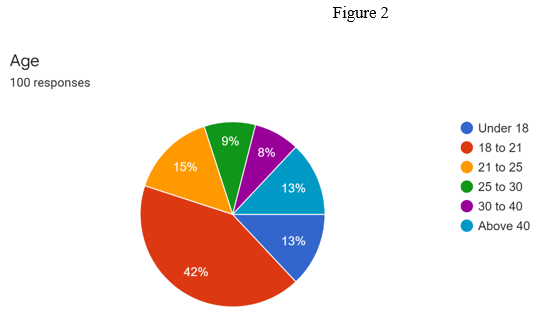
According to the age of respondents in figure 2, the study found that 13% of respondents were aged between under 18, this implies that in respondents who inexperience, and 42% of respondents aged between 18 to 21 and 15% represented the respondents aged between 21-25 and 9% represented the respondents aged between 25-30 and 8% represented the respondents aged between 30-40 apart from that 13% represented participants aged between Above 40 years. Therefore, the study indicated that most respondents are younger age.
3. Distance of Respondents
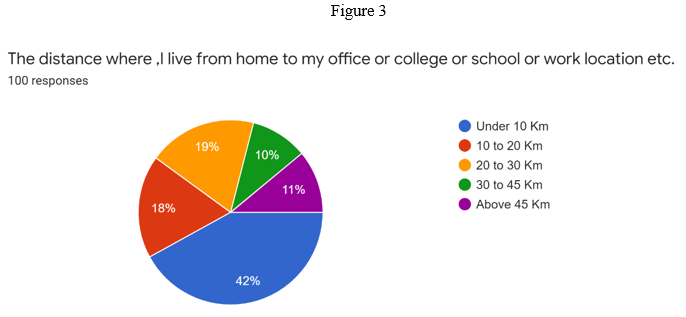
From the Figure 3, indicated that majority of the respondents 42% were under 10 km distance from where, they live from home to office, college, school, work location etc. Only 18% of the respondents were 10 to 20 km and 19% of respondents were 20 to 30 km and 10% of respondents were 30 to 45 km and 11% of the respondents were above 45 km range. Therefore, this implies that most of the respondents work location or school or office or college were under 10 km.
4. Ride/Day of Respondents
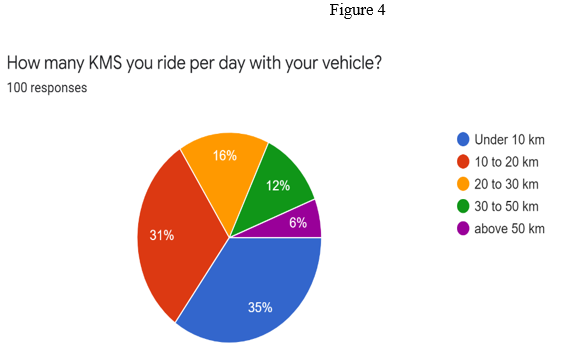
From the Figure 3, indicated that majority of the respondents 35% were under 10 km ride per day with their vehicle. Only 31% of the respondents were 10 to 20 km and 16% of respondents were 20 to 30 km and 12% of respondents were 30 to 45 km and 6% of the respondents were above 50 km range. Therefore, this implies that most of the respondent’s riding nature is upto 20km.
VI. QUESTIONNAIRE
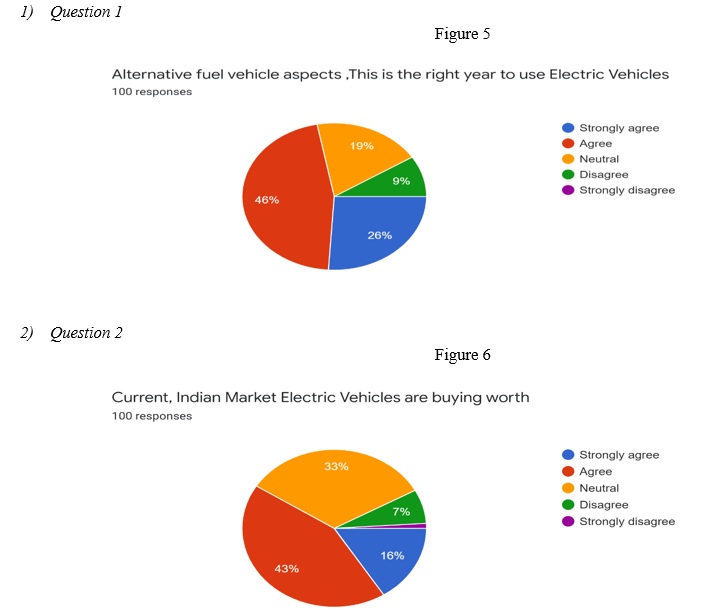
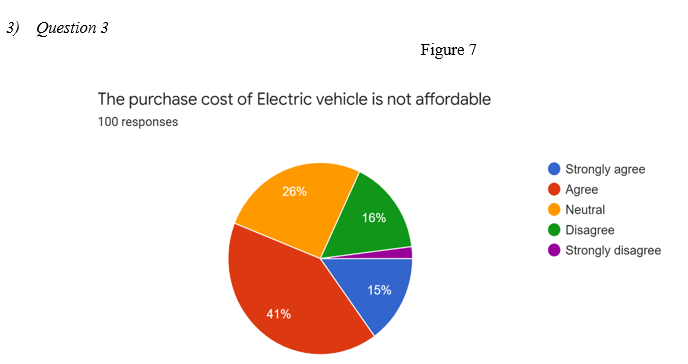
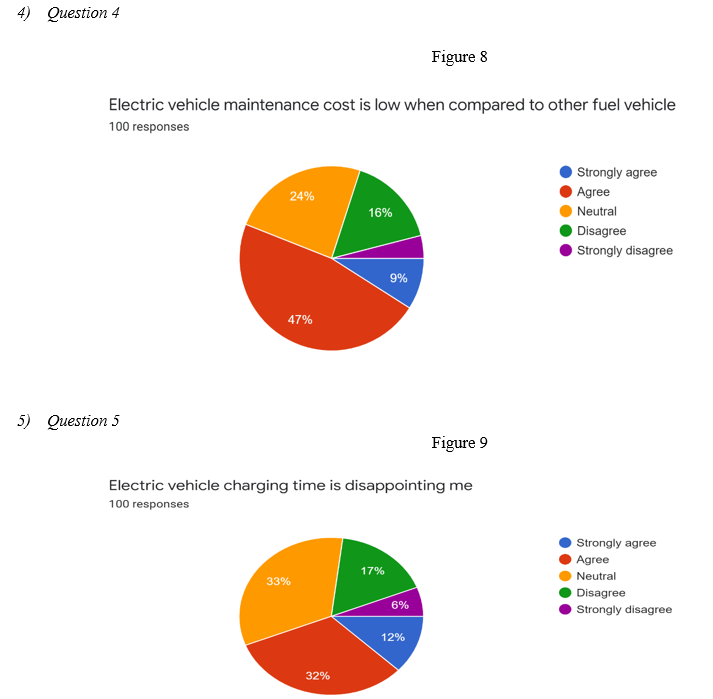
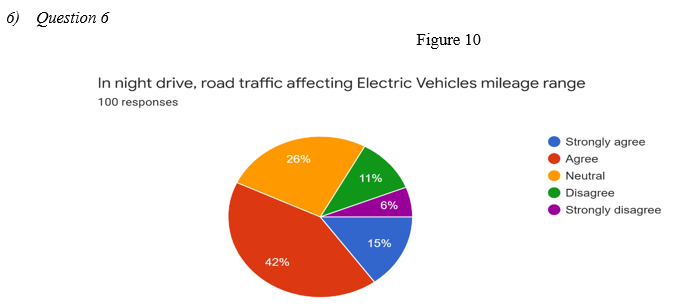
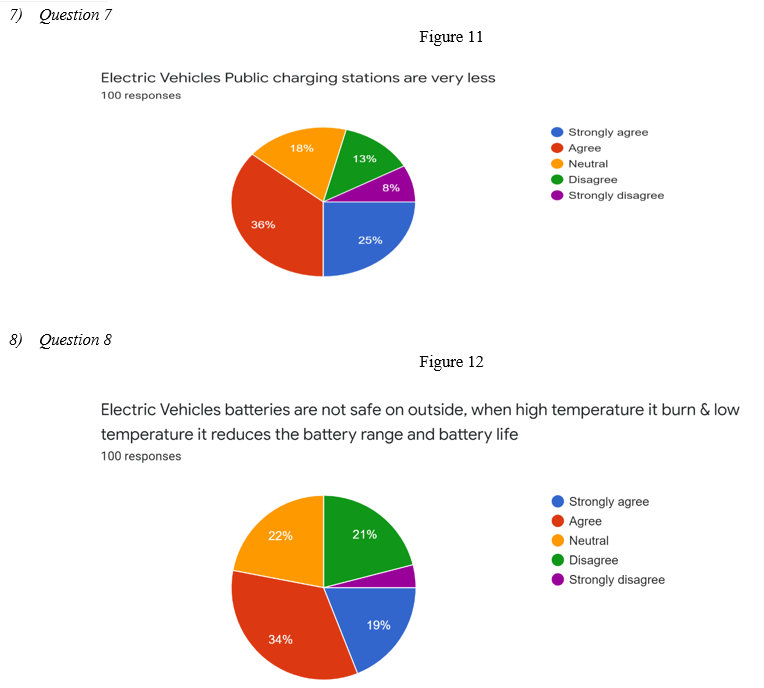
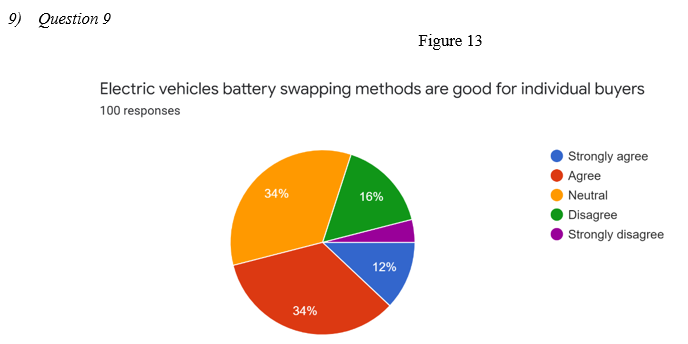
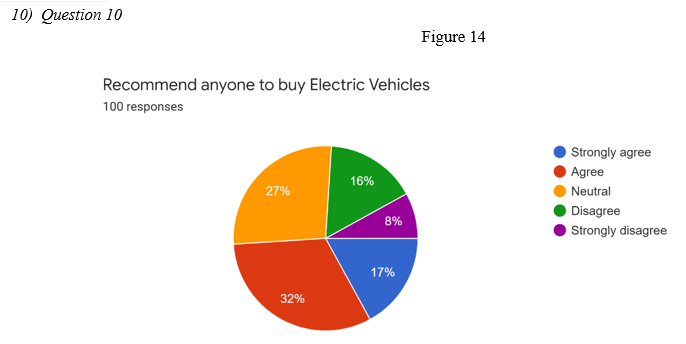
VII. DATA INTERPRETATION
From figure 5, 46% of respondents were agreed that, this is the right year to use electric vehicles in India 2022. From figure 6, 43% of respondents were agreed that Current, Indian market electric vehicles are buying worth and 33 % of respondents were neutral. From figure 7, 41% of respondents were agreed that, the purchase cost of electric vehicle is not affordable. From figure 8, 47% of respondents were agreed that, electric vehicle maintenance cost is low when compared to other fuel vehicle. From figure 9, 33% of respondents were neutral responses for electric vehicle charging time is disappointing me. From figure 10, 42 % of respondents were agreed that in night drive, road traffic affecting electric vehicles mileage range. From figure 11,33% of respondents were agreed that, electric vehicles public charging stations are very less. From figure 12, 34% of respondents were agreed that, electric vehicle batteries are not safe on outside, when high temperature it burn & low temperature it reduces the battery range and battery life. From figure 13, 34% of the respondents were agreed and neutral responses for electric vehicles battery swapping methods are good for individual buyers. From figure 14, 32% of the respondents were agreed that, recommend anyone to buy electric vehicles. Over all, every individual respondent responses are more positively expecting good electric vehicles.
VIII. PROBLEM IDENTIFICATION & SUGGESTION
A. Findings
- 2 – Wheeler Vehicle: In Two-wheeler segment somewhat satisfy the buyers that is the reason two-wheeler electric vehicle growth little bit higher than 4-wheeler segment market. But more cost cutting factor 2-wheeler electric vehicle quality is very poor. Anyhow 2-wheeler electric vehicle users’ day by day increasing step by step.
Table 1 shows comparison between reliable electric vehicle and petrol vehicle affordability & fuel cost aspects
|
TYPE OF VEHICLE ( SAME VARIANT FOR ALL ) |
VEHICLE PRICE ( SAME VARIANT FOR ALL ) |
SAVINGS FROM PRICE DIFFERENCE = ( RELIABLE ELECTRIC VEHICLE ) - ( PETROL OR RELIABLE ELECTRIC VEHICLE )
|
MILEAGE RANGE ( KM PER LITRE OR KM PER CHARGE ) |
CURRENT FUEL COST ( PRICE PER LITRE OR PRICE PER UNIT )
|
FUTURE FUEL COST ( PRICE PER LITRE OR PRICE PER UNIT ) |
FUTURE LITRES OR FUTURE CHARGE IN UNITS ( Approximate ) = ( PRICE DIFFERENCE ) / ( FUTURE FUEL COST ) |
FUTURE KMS = ( TOTAL FUTURE LITRE UNIT ) * ( MILEAGE PER LITRE OR PER CHARGE ) |
|
PETROL VEHICLE |
75,000 Rs |
25,000 Rs |
50 KMPL |
110 Rs |
170 Rs |
147 L |
7350 KM
|
|
RELIABLE ELECTRIC VEHICLE |
1 LAC Rs |
0 |
80 KMPC |
15 Rs |
25 Rs |
0 |
0 |
From table 1, The expected total future km is not satisfying the 2-wheeler petrol vehicle users. For normal person daily commute required only less than 100 km and battery power consumption is also very less that’s why electricity consumption tariff is not so high. Another thing is affordability of the 2-wheeler electric vehicle is somewhat ok. So, this is the reason behind people choosing 4-wheeler electric vehicle than 2-wheeler electric vehicle.
2. 4 – Wheeler Vehicle: Current Indian 4-wheeler electric vehicles are not fulfilling the Indian buyers. Lack of affordability, charging stations and charging time make no sense to buy 4-wheeler electric vehicles. If people consider about 4-wheeler electric vehicle as a third option for their list. So, need to compare with 4-wheeler reliable electric vehicle between 4-wheeler petrol / diesel vehicle affordability & fuel cost aspects. Let’s find out what is the reason behind these purchasing decisions.
Table 2 shows comparison between reliable electric vehicle and petrol / diesel vehicle affordability & fuel cost aspects
|
TYPE OF VEHICLE ( SAME VARIANT FOR ALL ) |
VEHICLE PRICE ( SAME VARIANT FOR ALL ) |
SAVINGS FROM PRICE DIFFERENCE = ( RELIABLE ELECTRIC VEHICLE ) - ( PETROL OR DIESEL VEHICLE OR RELIABLE ELECTRIC VEHICLE ) |
MILEAGE RANGE ( KM PER LITRE OR KM PER CHARGE ) |
CURRENT FUEL COST ( PRICE PER LITRE OR PRICE PER UNIT )
|
FUTURE FUEL COST ( PRICE PER LITRE OR PRICE PER UNIT ) |
FUTURE LITRES OR FUTURE CHARGE IN UNITS ( Approximate ) = ( PRICE DIFFERENCE ) / ( FUTURE FUEL COST ) |
FUTURE KMS = ( TOTAL FUTURE LITRE UNIT ) * ( MILEAGE PER LITRE OR PER CHARGE ) |
|
PETROL VEHICLE |
8 LACS |
7 LACS |
15 KMPL |
110 Rs |
170 Rs |
4117 L |
61755 KM
|
|
DIESEL VEHICLE |
9 LACS |
6 LACS |
18 KMPL |
100 Rs |
160 Rs |
3750 L
|
67500 KM |
|
RELIABLE ELECTRIC VEHICLE |
15 LACS |
0 |
210 KMPC |
15 Rs |
25 Rs |
0 |
0 |
From Table 2, The expected total future km is satisfying the 4-wheeler petrol and diesel vehicle users. For normal person daily commute required only less than 100 km but most of the 4-wheeler vehicle owners are using their vehicle for long range and battery power consumption is also very high that’s why electricity consumption tariff is high. In city most of the 4-wheeler owners are using 2-wheeler as the primary vehicle to eliminate the road traffic conditions to reach the destination without struggle. Another thing is affordability of the 4-wheeler electric vehicle is not at all worth at this price point. So, this is the reason behind people choosing 4-wheeler electric vehicle than 2-wheeler electric vehicle.
IX. SUGGESTION
- Identify the market need and follow up consumer behavior.
- Need to develop safest battery.
- Affordability of the electric vehicle is less than other fuel vehicle, then only drastic changes are happening in electric vehicle market.
- Need to improve build quality of the electric vehicle.
Conclusion
This article clearly stated that need not to promote electric vehicle as a brand. People never choose the branded electric vehicle; they were only choosing the reliable electric vehicle for their convenient use. This was observed when during the data collection. Most of the respondents are very well known about electric vehicle, which means that electric vehicle popularity is reached to every respondent. But the problem is how effective way to manufacturing the efficient and reliable electric vehicle to make them changes in purchasing decisions. Another major consideration is fewer charging stations are available & taking more time to recharge the electric vehicle. This is one of the reasons even electricity tariff is less, people not ready to adopt the change. Because world moving fast, no one ready to lot of time to wait & wasted to recharge the electric vehicle. The main reason is electric vehicle safety is very disappointing for all. Electric vehicle battery is not safe to use for low and high temperatures. It keeps on changing when temperature changes affect nature of the battery and battery performance, possibility to catch the fire or battery explosion happen to burnout the full vehicle easily. If any company manufacturing high durability & modern performance-based safest battery may impact on electric vehicle revolution otherwise people not ready to change the vehicle for their use because affordability & reliability of electric vehicle is still myth for buyers.
References
[1] El-fedany, Ibrahim, Driss Kiouach, and Rachid Alaoui. \"System architecture to select the charging station by optimizing the travel time considering the destination of electric vehicle drivers in smart cities.\" Bulletin of Electrical Engineering and Informatics 9, no. 1 (February 2020): 273–83. http://dx.doi.org/10.11591/eei.v9i1.1564. [2] Shakya, Rohit. \"A Study on Development of Electric Vehicles in India.\" International Journal for Research in Applied Science and Engineering Technology 9, VI (June 2021): 1175–77. http://dx.doi.org/10.22214/ijraset.2021.35156. [3] Zhao, Lianghong, Wensheng Hou, and Qinbo He. \"Intelligent of Electric Vehicle Heat Pump Air Conditioning Control System.\" Journal of Physics: Conference Series 2143, no. 1 (December 2021): 012043. http://dx.doi.org/10.1088/1742-6596/2143/1/012043. [4] Wang, Cheng, Tongtong Ji, Feng Mao, Zhenpo Wang, and Zhiheng Li. \"Prognostics and Health Management System for Electric Vehicles with a Hierarchy Fusion Framework: Concepts, Architectures, and Methods.\" Advances in Civil Engineering 2021 (January 2021): 1–11. http://dx.doi.org/10.1155/2021/6685900.
Copyright
Copyright © 2022 James Prasadh V. This is an open access article distributed under the Creative Commons Attribution License, which permits unrestricted use, distribution, and reproduction in any medium, provided the original work is properly cited.

Download Paper
Paper Id : IJRASET43280
Publish Date : 2022-05-25
ISSN : 2321-9653
Publisher Name : IJRASET
DOI Link : Click Here
 Submit Paper Online
Submit Paper Online

